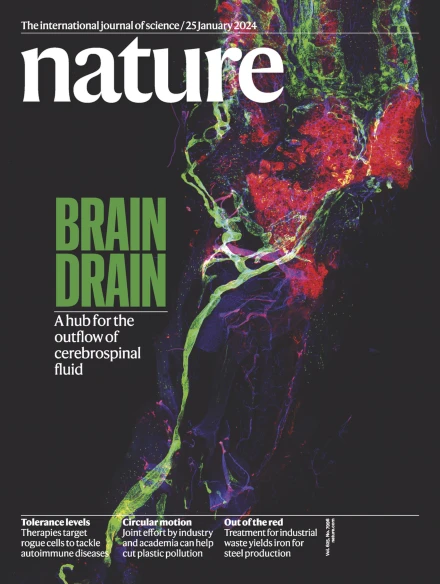自旋轨道耦合三层石墨烯的超导性和自旋倾斜
IF 48.5
1区 综合性期刊
Q1 MULTIDISCIPLINARY SCIENCES
引用次数: 0
摘要
石墨烯和过渡金属二硫化物平带体系显示出相似的相图,充满磁性的1、2、3、4、5和超导的6、7、8、9、10、11相。一个长期存在的问题是,磁有序是否会与超导性竞争,还是会促进配对。例如,最近对Bernal双层石墨烯的研究表明,在自旋轨道耦合增强的情况下,超导态的观察域和临界温度Tc大幅增加12,13,14;然而,这种增强的机制仍然未知。通过衬底接近效应在菱形三层石墨烯(RTG)中引入自旋轨道耦合可以产生新的超导口袋,电子和空穴掺杂的最大Tc≈300 mK,是六方氮化硼封装的RTG的3倍。利用局部磁强计,我们证明了超导跨越了具有有限面内磁矩的自旋倾斜状态和具有完全自旋谷锁定状态之间的过渡。这种转变在我们的Hartree-Fock计算中得到了复制,其中这种转变是由自旋轨道耦合和载流子密度调谐的洪德相互作用之间的竞争驱动的。我们的实验表明,自旋轨道耦合对超导性的增强是由倾斜角的定量变化而不是基态对称性的变化驱动的。这些结果与最近提出的超导性增强机制一致,其中自旋倾斜顺序的波动有助于配对相互作用。本文章由计算机程序翻译,如有差异,请以英文原文为准。


Superconductivity and spin canting in spin–orbit-coupled trilayer graphene
Graphene and transition metal dichalcogenide flat-band systems show similar phase diagrams, replete with magnetic1–5 and superconducting6–11 phases. An abiding question has been whether magnetic ordering competes with superconductivity or facilitates pairing. For example, recent studies of Bernal bilayer graphene in the presence of enhanced spin–orbit coupling show a substantial increase in the observed domain and critical temperature Tc of superconducting states12–14; however, the mechanism for this enhancement remains unknown. Here we show that introducing spin–orbit coupling in rhombohedral trilayer graphene (RTG) by substrate proximity effect generates new superconducting pockets for both electron and hole doping, with maximal Tc ≈ 300 mK, which is three times larger than in RTG encapsulated by hexagonal boron nitride. Using local magnetometry, we show that superconductivity straddles a transition between a spin-canted state with a finite in-plane magnetic moment and a state with complete spin–valley locking. This transition is reproduced in our Hartree–Fock calculations, in which this transition is driven by the competition between spin–orbit coupling and the carrier-density-tuned Hund’s interaction. Our experiment suggests that the enhancement of superconductivity by spin–orbit coupling is driven by a quantitative change in the canting angle rather than a change in the ground state symmetry. These results align with a recently proposed mechanism for the enhancement of superconductivity15, in which fluctuations in the spin-canting order contribute to the pairing interaction. Introducing spin–orbit coupling by substrate proximity effect leads to an enhancement of superconducting phases in rhombohedral trilayer graphene.
求助全文
通过发布文献求助,成功后即可免费获取论文全文。
去求助
来源期刊

Nature
综合性期刊-综合性期刊
CiteScore
90.00
自引率
1.20%
发文量
3652
审稿时长
3 months
期刊介绍:
Nature is a prestigious international journal that publishes peer-reviewed research in various scientific and technological fields. The selection of articles is based on criteria such as originality, importance, interdisciplinary relevance, timeliness, accessibility, elegance, and surprising conclusions. In addition to showcasing significant scientific advances, Nature delivers rapid, authoritative, insightful news, and interpretation of current and upcoming trends impacting science, scientists, and the broader public. The journal serves a dual purpose: firstly, to promptly share noteworthy scientific advances and foster discussions among scientists, and secondly, to ensure the swift dissemination of scientific results globally, emphasizing their significance for knowledge, culture, and daily life.
 求助内容:
求助内容: 应助结果提醒方式:
应助结果提醒方式:


